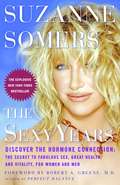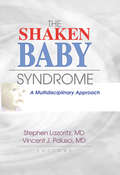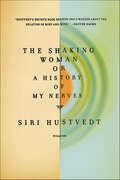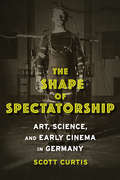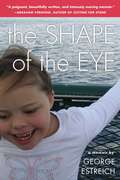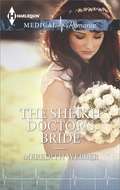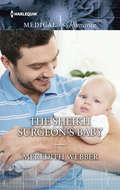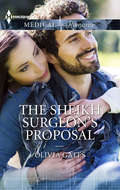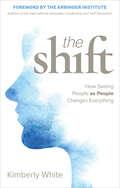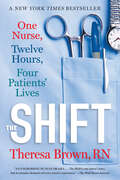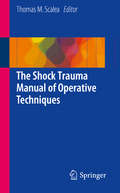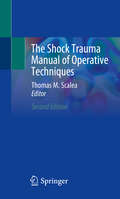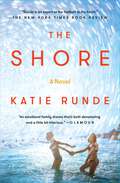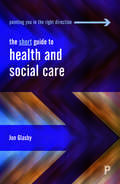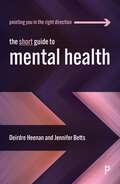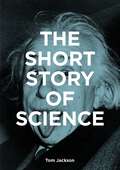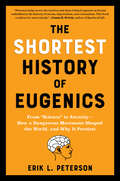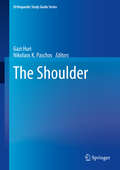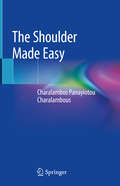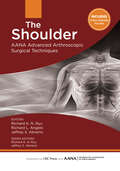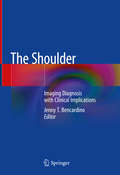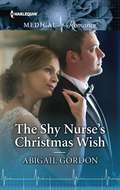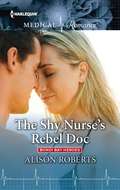- Table View
- List View
The Sexy Years: The Secret to Fabulous Sex, Great Health, and Vitality, For Women and Men
by Suzanne Somers Robert A. GreeneAn enlightening exploration of hormone replacement for both men and women
The Shaken Baby Syndrome: A Multidisciplinary Approach
by Vincent J. Palusci Stephen LazoritzDiagnose and treat shaken baby syndrome with advice from experts in the field!When an angry adult shakes a baby, the child may suffer brain damage, broken ribs, deafness, mental retardation, cerebral palsy, coma, or death. Often there are personal, ethical, and legal consequences as well for everyone involved. The Shaken Baby Syndrome: A
The Shaking Woman, or A History of My Nerves
by Siri HustvedtThe author delves into the mysteries of her own neurological condition in a far-ranging memoir that is “graceful, intense, and curiously affirming” (Booklist).While speaking at a memorial event for her father in 2006, novelist Siri Hustvedt suffered a violent seizure from the neck down. Despite her flapping arms and shaking legs, she continued to speak clearly and was able to finish her speech. It was as if she had suddenly become two people: a calm orator and a shuddering wreck. Then the seizures happened again and again.The Shaking Woman or A History of My Nerves tracks Hustvedt’s search for a diagnosis, one that takes her inside the thought processes of several scientific disciplines, each one of which offers a distinct perspective on her paroxysms but no ready solution. In the process, she finds herself entangled in fundamental questions: What is the relationship between brain and mind? How do we remember? What is the self?In The Shaking Woman, Hustvedt synthesizes her experience and research into a compelling mystery: Who is the shaking woman? In the end, the story she tells becomes, in the words of George Makari, author of Revolution in Mind, “a brilliant illumination for us all.”
The Shape of Spectatorship: Art, Science, and Early Cinema in Germany (Film and Culture Series)
by Scott CurtisScott Curtis draws our eye to the role of scientific, medical, educational, and aesthetic observation in shaping modern spectatorship. Focusing on the nontheatrical use of motion picture technology in Germany between the 1890s and World War I, he follows researchers, teachers, and intellectuals as they negotiated the fascinating, at times fraught relationship between technology, discipline, and expert vision. As these specialists struggled to come to terms with motion pictures, they advanced new ideas of mass spectatorship that continue to affect the way we make and experience film. Staging a brilliant collision between the moving image and scientific or medical observation, visual instruction, and aesthetic contemplation, The Shape of Spectatorship showcases early cinema's revolutionary impact on society and culture and the challenges the new medium placed on ways of seeing and learning.
The Shape of the Eye
by George Estreich"[An] elegantly written, unsentimental memoir."--PEOPLE MAGAZINE [PEOPLE's Pick of the Week] When Laura Estreich is born, her appearance presents a puzzle: does the shape of her eyes indicate Down syndrome, or the fact that she has a Japanese grandmother? In this powerful memoir, George Estreich, a poet and stay-at-home dad, tells his daughter's story, reflecting on her inheritance --- from the literal legacy of her genes, to the family history that precedes her, to the Victorian physician John Langdon Down's diagnostic error of "Mongolian idiocy." Against this backdrop, Laura takes her place in the Estreich family as a unique child, quirky and real, loved for everything ordinary and extraordinary about her. "In this wise and moving memoir, George Estreich tells the story of his family as his younger daughter is diagnosed with Down syndrome and they are thrust into an unfamiliar world. Estreich writes with a poet's eye and gift of language, weaving this personal journey into the larger history of his family, exploring the deep and often hidden connections between the past and the present. Engaging and unsentimental, The Shape of the Eye taught me a great deal. It is a story I found myself thinking about long after I'd finished the final pages." --Kim Edwards, author of The Memory Keeper's Daughter "A poignant, beautifully written, and intensely moving memoir" --Abraham Verghese, author of Cutting for Stone "The Shape of the Eye is a memoir of a father's love for his daughter, his struggle to understand her disability, and his journey toward embracing her power and depth. Estreich is raw and honest and draws us each into a new view of what it means to be 'human' and what it means to be 'different.' This book is beautifully written, poetically insightful, and personally transformative. To read it is to rethink everything and to be happy because of the journey." --Timothy P. Shriver, Ph.D., Chairman & CEO of the Special Olympics "The Shape of the Eye personalizes Down syndrome, bringing a condition abstracted in the medical literature into the full dimensionality of one family's life. It's brave of George Estreich to make what has befallen his family so public, trusting of him to let an unknown audience second-guess the family's choices. Because he's opened his home and heart in this memoir, we are privileged to witness in chaotic, heart-wrenching, joyous detail what it means to have and to love a child with Down syndrome." --Marcia Childress, Associate Professor of Medical Education (Medical Humanities), University of Virginia School of Medicine
The Sheikh Doctor's Bride
by Meredith WebberMarried to the Sheikh... ER doctor Kate will do anything to save her family's livelihood. So when the Sultan of Amberach offers her a lifeline in exchange for her working in his state-of-the-art hospital and marrying his nephew-gorgeous, brooding sheikh Dr. Fareed Faruke-it's a deal Kate has to accept! Fareed has always known he'll never have a say in who he marries, but he's shocked to see beautiful Kate behind the gold silk veil. She's the one woman he shouldn't want-and yet the only woman he can't seem to resist...
The Sheikh Surgeon's Baby
by Meredith WebberCharmed by a mother and her little girl Heart surgeon Melissa Cartwright is traveling to Zaheer to tell Sheikh Arun Rahman al'Kawali she is pregnant with his child. She wants nothing from him—she guards her heart as fiercely as he guards his. The Arun learns of Melissa's baby bombshell, and for him marriage is the only answer. Yet before she can accept the sheikh surgeon's proposal, Melissa needs to be sure of his love.
The Sheikh Surgeon's Proposal
by Olivia GatesThe sheikh doctor's virgin wife Caught up in the frantic and romantic whirl of life as an emergency doctor in the desert kingdom of Damhoor, Jay Latimer is swept off her feet by her handsome boss, playboy surgeon Sheikh Malek Aal Hamdaan. Malek is entranced by Jay's luminous strength and beauty, but while he is an eligible bachelor, he is also heir to the throne and, therefore, not free to choose his own bride. Malek knows he can offer Jay a loving and passionate relationship--but he also knows that the only proposal she deserves and can accept is to become his wife.
The Shift: How Seeing People as People Changes Everything
by Kimberly WhiteA Simple yet Profound ShiftSeeing people as people is an idea so simple you'll swear you've heard it a million times but so profound you'll never stop learning from it. Kimberly White discovered it in a chain of nursing homes whose leaders, nurses, and housekeepers saw their patients, not as tasks to be ticked off a to-do list, but as valuable human beings.White helps you to this transformative shift with warm encouragement, insightful guidance, and powerfully moving, true accounts of extraordinary human goodness.
The Shift: One Nurse, Twelve Hours, Four Patients' Lives
by Theresa Brown“Compelling and compassionate human drama. If you want to understand how modern medicine ticks, fasten your seat belt and spend a day in the hospital with Theresa Brown on The Shift.” —Danielle Ofri, MD, author of What Doctors Feel In a book as eye-opening as it is riveting, practicing nurse and regular contributor to the New York Times Theresa Brown invites us to experience not just a day in the life of a nurse but all the life that happens in just one day on a busy teaching hospital’s cancer ward. In the span of twelve hours, lives can be lost, life-altering treatment decisions made, and dreams fulfilled or irrevocably stolen. Every day, Theresa Brown holds these lives in her hands. On this day, there are four. Unfolding in real time under the watchful eyes of Theresa Brown--a dedicated nurse and an insightful chronicler of events--we are given an unprecedented view into the individual struggles as well as the larger truths about medicine in this country. By shift’s end, we have witnessed something profound about hope and humanity. “This meticulous, absorbing shift-in-the-life account of one nurse’s day on a cancer ward stands out for its honesty, clarity, and heart. Brown . . . juggles the fears, hopes, and realities of a 12-hour shift in a typical urban hospital with remarkable insight and unflagging care. Her memoir is a must-read for nurses or anyone close to one.” —Publishers Weekly, starred review “An empathetic and absorbing narrative as riveting as a TV drama.” —Kirkus Reviews “I am filled with awe and gratitude for the work that the nurses like Theresa Brown do every day. She captures perfectly their central role in any patient’s life!” —Susan M. Love, MD, chief visionary officer, Dr. Susan Love Research Foundation, and author of Dr. Susan Love’s Breast Book
The Shock Trauma Manual of Operative Techniques
by Thomas M. ScaleaThis manual provides a practical approach to operative trauma management. Written entirely by physicians who currently practice in shock trauma, the manual features a hands-on approach and practice to dealing with shock trauma that is regularly utilized by the faculty at the R Adams Cowley Shock Trauma Center. The volume includes numerous photographs that illustrate operative techniques in great detail. The book is also presented in a manual format so that it fits easily into a white coat pocket, making it a portable and readily accessible reference. The Shock Trauma Manual of Operative Techniques is a valuable resource for practicing surgeons in the community who cover the Emergency Department and thus, may be called upon to provide operative therapy for trauma, residents, particularly those in whom operative trauma is not a part of their training, and fellows who are training in surgical critical care and trauma.
The Shock Trauma Manual of Operative Techniques
by Thomas M. ScaleaThis book acts as a portable and easy-to-understand reference for surgical trainees or young faculty members that are interested in reviewing procedures on the way to the operating room. This second edition aims to provide a practical hands-on approach to operative trauma management. Following the success of the first edition, chapters were revised, updated, and added due to substantial changes in trauma care over the past few years. Several new experts contributed their knowledge and techniques inside this new edition. For example, chapters on fasciotomy and resuscitative endovascular balloon occlusion of the aorta (REBOA) have been added.The second edition of The Shock Trauma Manual of Operative Techniques is a valuable reference for practicing surgeons in the community and serves to aid trauma practitioners as they attempt to deal with operative challenges.
The Shore: A Novel
by Katie RundeSet over the course of one summer, this perfect beach read follows a mother and her two daughters as they grapple with heartbreak, young love, and the weight of family secrets.Brian and Margot Dunne live year-round in Seaside, just steps away from the bustling boardwalk, with their daughters Liz and Evy. The Dunnes run a real estate company, making their living by quickly turning over rental houses for tourists. But the family&’s future becomes even more precarious when Brian develops a brain tumor, transforming into a bizarre, erratic version of himself. Amidst the chaos and new caretaking responsibilities, Liz still seeks out summer adventure and flirting with a guy she should know better than to pursue. Her younger sister Evy works in a candy shop, falls in love with her friend Olivia, and secretly adopts the persona of a middle-aged mom in an online support group, where she discovers her own mother&’s most vulnerable confessions. Meanwhile, Margot faces an impossible choice driven by grief, impulse, and the ways that small-town life in Seaside has shaped her. Falling apart is not an option, but she can always pack up and leave the beach behind. The Shore is a powerful, heartbreaking, and ultimately uplifting novel infused with humor about young women finding sisterhood, friendship, and love in a time of crisis. This big-hearted family saga examines the grit and hustle of running a small business in a tourist town, the ways we connect with strangers when our families can&’t give us everything we need, and the comfort to be found in embracing the pleasures of youth while coping with unimaginable loss.
The Short Guide to Health and Social Care (Short Guides)
by Jon GlasbyAs a field, health and social care is facing considerable challenge and debate, in the UK and internationally. This clear and succinct text offers a valuable introductory guide to this multidisciplinary subject, helping people who want to study or work in health and social care understand why these services matter, how they have developed and how they work. Framed by vital historical and social policy context, the book considers: · The social context in which health and social care are delivered · The history and nature of current services · Organising, funding and delivering services · How to be a professional in practice Including chapter summaries and links to further reading, this text will be invaluable to undergraduate students on programmes in Health and Social Care, Social Work, Nursing, Allied Health Professions, Social Policy and related applied social science subjects, as well as to A-level and Foundation programmes prior to University.
The Short Guide to Mental Health (Short Guides)
by Deirdre Heenan Jennifer BettsIn this clear and concise primer, Deirdre Heenan and Jennifer Betts lay out key concepts and debates in the field of mental health. With overviews of recent developments and stakeholder perspectives, the book introduces contemporary themes in policy and practice. It explores the prevalence, cost and social determinants of mental illness, the changing attitudes and stigma around them, and the roles of the state, voluntary and community sectors in designing and delivering services. Assuming no prior knowledge of the subject, the guide includes: • text boxes and figures to illustrate key points; • end of chapter summaries; • international case studies; • further reading guides. For students, practitioners, policy makers and newcomers alike, this is an accessible and comprehensive guide to an increasingly prioritised and debated topic.
The Short Story of Science: A Pocket Guide to Key Histories, Experiments, Theories, Instruments and Methods
by Tom Jackson Mark Fletcher'Nothing in life is to be feared. It is only to be understood. Now is the time to understand more, so that we may fear less' Marie CurieThe Short Story of Science is a new introduction to the complete subject of science. Covering 60 key experiments, from Archimedes' investigations of buoyancy to the discovery of dark matter, and then linking these to the history of science, as well as to the key theories and methods, the book simplifies and explains all the key breakthroughs.Accessible and concise, generously illustrated throughout, and with all the essential information presented without jargon, readers are given all the tools they need to enjoy the fascinating history of scientific knowledge.
The Short Story of Science: A Pocket Guide to Key Histories, Experiments, Theories, Instruments and Methods
by Tom Jackson Mark Fletcher'Nothing in life is to be feared. It is only to be understood. Now is the time to understand more, so that we may fear less' Marie CurieThe Short Story of Science is a new introduction to the complete subject of science. Covering 60 key experiments, from Archimedes' investigations of buoyancy to the discovery of dark matter, and then linking these to the history of science, as well as to the key theories and methods, the book simplifies and explains all the key breakthroughs.Accessible and concise, generously illustrated throughout, and with all the essential information presented without jargon, readers are given all the tools they need to enjoy the fascinating history of scientific knowledge.
The Shortest History of Eugenics: From "Science" to Atrocity - How a Dangerous Movement Shaped the World, and Why It Persists (The Shortest History Series #0)
by Erik PetersonA harrowing history of a grim chapter in politics and science, in which groups of influential thinkers shaped global policy with the aim of determining who had the right to have children—and who was worthy of life. The Shortest History books deliver thousands of years of history in one riveting, fast-paced read. For the last two centuries, groups of influential men have, in the professed interest of fiscal responsibility, crime reduction, and outright racism, attempted to control who was allowed to bear children. Their efforts, “eugenics,” characterize a movement that over the last century swept across the world—from the US to Brazil, Japan, India, Australia, and beyond—in the form of marriage restrictions, asylum detention, and sterilization campaigns affected millions. German physicians and scientists adopted and then heightened these eugenics practices beginning in 1939, starving or executing those they deemed “life unworthy of life.” But well after the liberation of Nazi deathcamps, health care workers and even the US government pursued policies worldwide with the express purpose of limiting the reproduction of poor non-whites. The Shortest History of Eugenics takes us back to the founding principles of the movement, revealing how an idea that began in cattle breeding took such an insidious turn—and how it lingers in rhetoric and policy today.
The Shoulder
by Gazi Huri Nikolaos K. PaschosThis book provides a broad overview of operative and non-operative treatments of various conditions affecting the shoulder. It is presented in an easy to use format with each chapter including multiple choice questions to assist the reader in preparing for boards to improve shoulder knowledge and increase success in exams. The Shoulder clearly describes the basic science, anatomy, biomechanical features and principals of physical examination while utilising an algorithmic approach to shoulder disorders. The contributors are an international team of shoulder experts who understand what is important to know at every level. The result is a book of value to those new to shoulder challenges and also experienced surgeons who wish to have a quick and handy guide to current concepts and knowledge of shoulder conditions and treatment.
The Shoulder Made Easy
by Charalambos Panayiotou CharalambousThis book provides a concise and up-to-date resource on common shoulder disorders. The reader will learn about various shoulder conditions, their presentation, evaluation and management. Anatomy, biomechanics, function, clinical history taking and examination, radiological imaging and other investigations, as well as principles of non-surgical and surgical management of the troublesome shoulder are presented first. The Shoulder Made Easy conveys clear, easily understood information to help practitioners in day-to-day clinical practice as well as in preparation for undergraduate or postgraduate exams. The book focuses on:Commonly encountered clinical symptoms of the shoulder: patients don't present with a clinical diagnosis but with symptoms such as pain, stiffness, weakness or instability and a thorough consideration of what could be accounting for such symptoms and how such symptoms may be dealt with is presented.Commonly encountered clinical disorders of the shoulder: each clinical disorder is concisely presented with the background, clinical symptoms, investigations, differential diagnosis, treatment and a further reading section. This book attempts to present information in an easily read, succinct way. In particular, this book tries to unpick and explain those concepts of shoulder disorders that may be difficult to understand. An attempt is made to pass on knowledge but more importantly also stimulate lateral thinking. Key diagrams, clinical photographs and radiographs are used as necessary to highlight important points; references to relevant landmark articles are also provided in each chapter. The book will be of great interest to medical students, junior orthopaedic doctors, GP’s and physiotherapists.
The Shoulder: AANA Advanced Arthroscopic Surgical Techniques (AANA Advanced Arthroscopic Techniques series)
by Jeffrey Abrams Richard Ryu Richard AngeloCo-published with the Arthroscopy Association of North America, The Shoulder: AANA Advanced Arthroscopic Surgical Techniques is a comprehensive technique-based book that presents the latest diagnostic and reconstructive techniques in arthroscopic surgery for the shoulder.The Shoulder: AANA Advanced Arthroscopic Surgical Techniques is authored by premier arthroscopic surgeons Drs. Richard K.N. Ryu, Richard L. Angelo, and Jeffrey S. Abrams, and their international list of expert contributors. This comprehensive resource includes preferred physical examination testing and diagnostic imaging choices in pre-operative planning and patient selection, state-of-the-art step-by-step description of the procedures, detailed surgical equipment lists to perform each procedure, clear and precise indications for surgery and the thoughtful rationale behind stated contraindications, controversial indications, post-operative protocols, and potential complications.The written text is supported by numerous color images and a website with invaluable, narrated video clips depicting disease-specific arthroscopic techniques specific to the shoulder.Features inside The Shoulder: AANA Advanced Arthroscopic Surgical Techniques Narrated video accompanies all surgical techniques, focusing on the stepwise approach to each operation Consistent organization throughout the book results in a bulleted and user-friendly interface for a quick reference or prolonged study Top 5 Technical Pearls for each procedure to enhance outcomes and to avoid common pitfalls and complications High-quality artwork and figures to complement clinical images Equipment and surgical technique checklists for quick reference prior to surgery Each expert contributor was chosen for his or her expertise for a specific topic related to The Shoulder, so the reader benefits by the highest quality and treatment recommendations to provide state-of-the-art care to his or her patient.Some chapter topics include: Arthroscopic Latarjet Stabilization Arthroscopic A-cromioclavicular Joint Reconstruction Arthroscopic Subscapularis Repair: The Extra-Articular Technique Arthroscopic Suprascapular Nerve Release Arthroscopic Suprapectoral Biceps Tenodesis
The Shoulder: Imaging Diagnosis with Clinical Implications (The\clinics: Radiology Ser. #20-2)
by Jenny T. BencardinoThis book covers all aspects of imaging diagnosis of shoulder disorders from a clinical perspective. After discussion of relevant imaging techniques, a wide spectrum of disorders is addressed in a series of dedicated chapters on rotator cuff injuries and impingement syndromes, biceps tendon and rotator interval pathology, glenohumeral instability, SLAP tears and microinstability, shoulder girdle fractures, shoulder arthropathies, tumors and tumor-like conditions, and entrapment neuropathies. Separate consideration is also given to the pediatric shoulder and to preoperative planning, postoperative imaging, and surgical techniques in patients undergoing shoulder arthroplasty.The unique anatomy and range of motion of the shoulder joint can present a diagnostic challenge. Characterization of soft tissue injuries and radiographically occult osseous pathology is often facilitated by the use of advanced imaging techniques, including MRI, CT, and ultrasound. Readers will find this excellently illustrated book to be an invaluable aid to diagnostic interpretation when employing these techniques.
The Shroud Conspiracy: A Thriller (The Shroud Series #1)
by John Heubusch“The Shroud Conspiracy is an absolutely brilliant thriller!” —Brad Thor, #1 New York Times bestselling author of Foreign Agent In this intense thriller, a forensic anthropologist sets out to prove that the Shroud of Turin is a fake, but quickly discovers the opposite—and must race to stop the evil forces who want to use traces of blood in the fabric to clone Jesus Christ and bring on the second coming of their own design.Throughout his career, forensic anthropologist and outspoken atheist Dr. Jon Bondurant has investigated many religious artifacts said to be real, but he knows better. Only weak minds rely on such obviously false relics to maintain their silly, pointless faith. So when he is invited by the Vatican to examine the Shroud of Turin, said to be the burial cloth that covered the body of Christ—and the most revered of all Christian artifacts—he is delighted for the opportunity to prove once and for all that the Shroud is a fake. But when he meets Domenika Josef, the beautiful and devout Vatican representative who finds him arrogant and self-important, he realizes his task will not be as straightforward as he once imagined. Domenika believes that the relic is real, and wants nothing more than to rescue the tarnished reputation of the church by announcing the good news. As Bondurant and his team examine every element of the Shroud, he and Domenika begin to see each other in a whole new light. And as the evidence about the origin of this highly contested piece of fabric starts to pile up, he begins to realize that he’s been seeing a lot of things incorrectly. But when a sample of the blood from the Shroud—believed to be the real blood of Jesus Christ—vanishes, he realizes his problems are just beginning. The DNA traces in that sample could have earth-shattering consequences if they fall into the wrong hands. When Domenika vanishes too, Bondurant is caught in a globe-spanning chase to rescue the woman he loves—and stop the evil forces who have their own motives for bringing on the Second Coming.
The Shy Nurse's Christmas Wish
by Abigail GordonFrom shy nurse…To Christmas bride!Darcey Howard has come to the beautiful seaside town of Seahaven for a fresh start. Working over Christmas in the children’s ward at Oceans House will help her forget her traumatic past. But her quiet, safe existence is shattered by gorgeous surgeon Daniel Osbourne. Enigmatic Daniel is the last man she should fall for, but he’s just too tempting to resist!
The Shy Nurse's Rebel Doc: The Shy Nurse's Rebel Doc (bondi Bay Heroes) / Finding His Wife, Finding A Son (bondi Bay Heroes) (Bondi Bay Heroes #1)
by Alison RobertsFrom playing it safe…To falling for her rebel boss!In this Bondi Bay Heroes story, ER nurse Samantha Braithwaite has learnt never to put limits on herself. But working with Dr. Blake Cooper is her biggest challenge yet. He thinks she’s shy, but that makes her more determined to prove she can make the Specialist Disaster Response team. And as days spill into nights, the chemistry they’ve tried to hide is about to explode!
